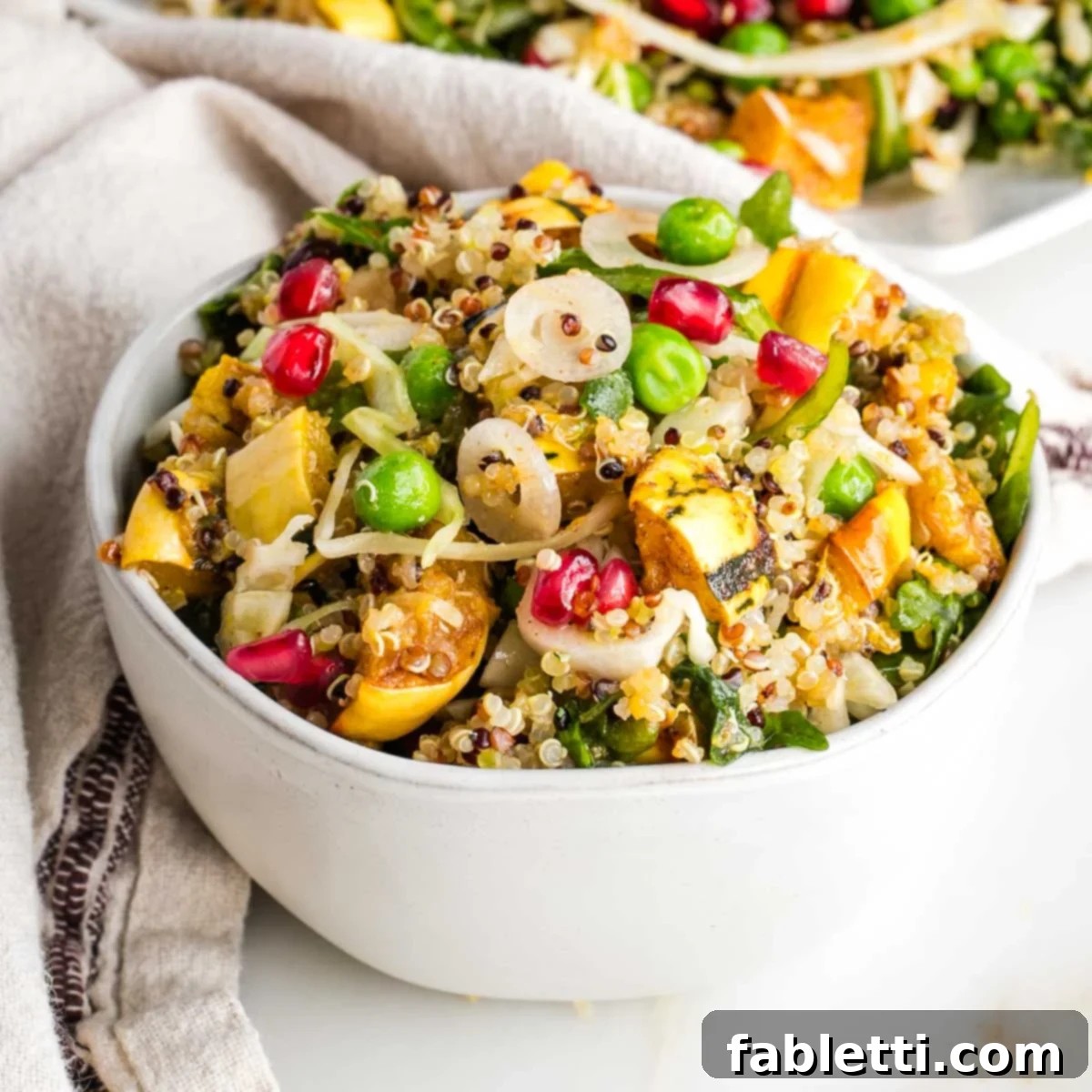Transform your autumn and winter dining with this spectacular Roasted Squash and Pomegranate Salad, a vibrant dish that promises to make all your seasonal salad dreams come true. More than just a simple side, this robust creation, featuring crisp arugula and protein-packed quinoa, is generously coated in a bright Maple Vinaigrette, making it an ideal hearty lunch or a satisfying light dinner. Its dynamic flavors and textures offer a refreshing take on comfort food, perfect for any occasion.

The magic of this salad lies in its thoughtful combination of easy-to-prepare components that deliver a high-impact culinary experience. The star of the show, perfectly roasted delicata squash, brings a naturally sweet and earthy flavor profile, complemented by warm, aromatic spices. When combined with the peppery kick of arugula, the nutty chewiness of quinoa, and the sparkling burst of pomegranate seeds, every forkful is an adventure in taste and texture. This plant-based masterpiece is not only incredibly delicious but also remarkably simple to assemble, proving that wholesome vegan comfort food can be both effortless and extraordinary.
Our recipe highlights the delightful roasted delicata squash with cozy spices. Delicata squash is truly a kitchen hero, especially for a quick and easy fall salad. Its tender texture and inherent sweetness are perfectly enhanced by roasting. Best of all, there’s no need to peel it – its skin softens beautifully in the oven and is entirely edible, saving you precious prep time. This makes it a fantastic choice for those busy weeknights when you crave something wholesome yet don’t want to spend hours in the kitchen. As the squash roasts and the quinoa simmers, you can effortlessly prepare the remaining ingredients, allowing you to whip up this impressive harvest salad in under 30 minutes. What a bravo-worthy feat!
Should delicata squash not be readily available, acorn squash makes an excellent substitute, sharing the convenient trait of having an edible skin. This means you can enjoy the same ease of preparation, avoiding the extra step of peeling. While roasted butternut squash is also a wonderful addition to salads, if you opt for it, consider purchasing it pre-peeled and cubed to maintain the swift and simple theme of this recipe. However, if your heart is set on a dedicated butternut squash creation, I highly recommend exploring my exquisite butternut and beetroot salad – it’s truly divine and offers another unique flavor journey.
Key Ingredients and Smart Substitutions
Crafting the perfect salad often comes down to the quality and combination of its ingredients. This section dives into the core components of our Roasted Squash and Pomegranate Quinoa Salad, along with suggestions for smart substitutions that can adapt the recipe to your pantry or dietary preferences. Each element plays a crucial role in creating a harmonious blend of flavors, textures, and nutritional benefits.
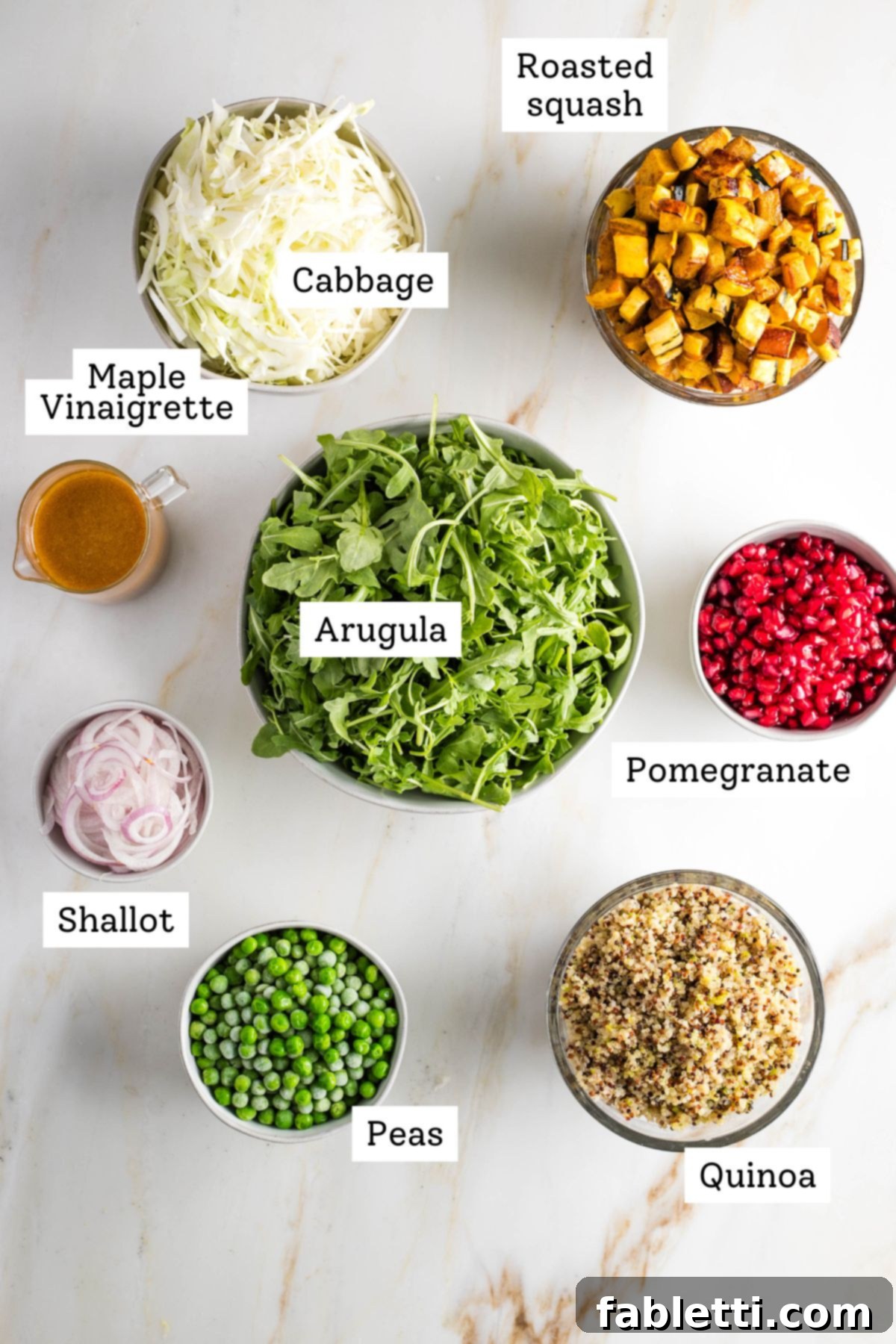
- Greens: While fresh, peppery arugula provides a wonderful base for this salad, feel free to experiment with other leafy greens. Thinly sliced elephant kale, known for its sturdy texture and slightly sweet flavor, works fabulously as an addition or a complete substitute. For a salad that stands up well to being made ahead or as leftovers, opt for heartier greens like kale, collard greens, shredded Brussels sprouts (or their tender tops), radicchio for a touch of bitterness, or Swiss chard. These robust greens will maintain their integrity and crunch even after being tossed with dressing.
- Quinoa: This ancient “grain” is technically a seed, celebrated for its impressive nutritional profile. It’s a naturally gluten-free choice that significantly boosts the protein content of the salad compared to many traditional grains, making it exceptionally satisfying. Beyond protein, quinoa is also an excellent source of dietary fiber, aiding digestion and promoting satiety. If you’re looking for other high-protein grain alternatives, consider spelt, kamut, teff, or amaranth for a similar wholesome experience.
- Roasted Squash: Delicata squash is our top recommendation for its incredibly tender flesh and naturally sweet flavor, which pairs beautifully with warm spices. Its most appealing feature is its edible skin, eliminating the need for peeling and simplifying preparation. Acorn squash offers a similar texture and the same convenient edible skin, making it a perfect substitute. While other winter squash varieties like butternut or kabocha can certainly be used, be aware that they typically require peeling, adding an extra step to your cooking process.
- Maple Vinaigrette: This homemade dressing is a cornerstone of the salad’s flavor profile. It’s incredibly quick and easy to prepare, requiring just a handful of simple pantry staples. The maple syrup provides a delicate sweetness that beautifully balances the tang of apple cider vinegar, creating a truly delicious and versatile dressing that can be used on many other salads as well.
- Peas: Frozen peas are a brilliant addition for their vibrant color, subtle sweetness, and convenience – simply thaw and add! For a different flavor and protein boost, consider substituting with frozen shelled edamame, which offers a similar texture. Other fantastic bean alternatives include chickpeas, kidney beans, or small white beans, adding to the salad’s hearty appeal.
- Cabbage: Finely shredded green or red cabbage introduces a delightful crunch, appealing texture, and a burst of color to the salad. Beyond its textural contribution, cabbage also offers a wealth of vitamins and fiber. Savoy cabbage, with its crinkly leaves, or napa cabbage, known for its milder flavor, are both excellent choices that integrate seamlessly into the mix.
- Shallots: Slicing shallots super thin or dicing them finely ensures a delicate, aromatic touch in every bite without overpowering the other flavors. Shallots add a subtle oniony sweetness and a slight pungency. If shallots are unavailable, thinly sliced scallions (green onions) or a small amount of finely minced red onion can serve as suitable substitutes, offering a similar aromatic depth.
Mastering the Art of Roasting Delicata Squash for Salad
Roasting delicata squash transforms this humble vegetable into a caramelized, tender, and incredibly flavorful component for our salad. Follow these simple steps to achieve perfectly roasted squash every time, infusing it with warm, inviting spices that sing of autumn.
Preheat your oven to a robust 400 degrees Fahrenheit (200 degrees Celsius). This temperature ensures the squash cooks through evenly while developing a beautiful golden-brown exterior.
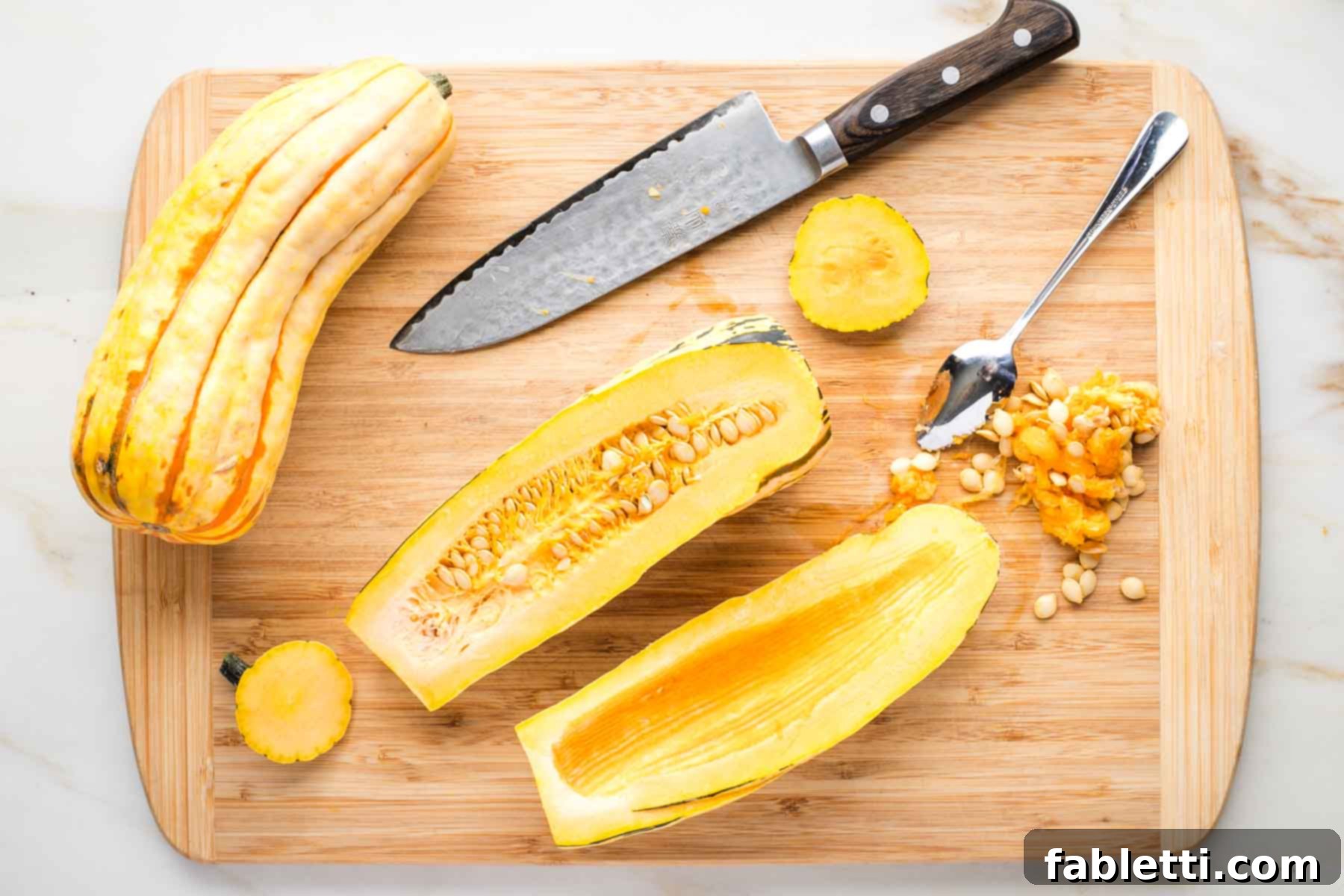
Begin by giving your delicata squash a thorough wash under running water, then pat it completely dry with a clean kitchen towel. A dry surface helps achieve better caramelization. The beauty of delicata squash is that peeling is entirely optional; its thin skin becomes wonderfully tender when roasted. Next, trim off both ends of the squash. Carefully cut each squash in half lengthwise from stem to blossom end. Using a spoon, scoop out the seeds and fibrous strands from the center of each half. A grapefruit spoon works exceptionally well for this task due to its serrated edge, making seed removal effortless.
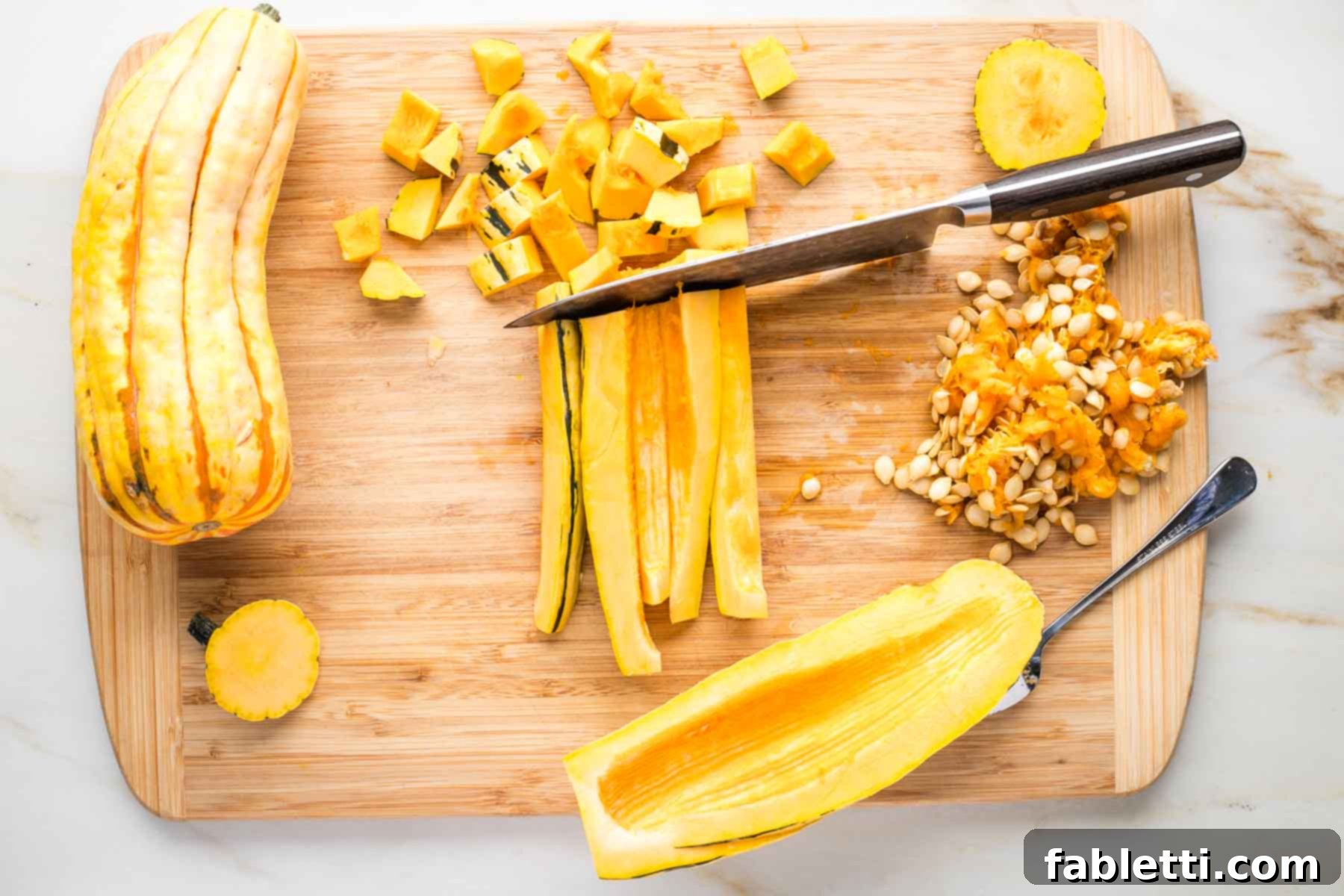
Once the squash halves are clean, place each one skin-side down on your cutting board. Slice them lengthwise into uniform ¼-inch strips. Consistency in size is key for even cooking. Then, rotate the strips and cut across them to create ¼-inch cubes. These bite-sized pieces are perfect for salads, ensuring a balanced texture in every mouthful. Aim for cubes that are roughly the same size to ensure they roast uniformly and reach optimal tenderness at the same time.

Transfer the diced squash onto a large, rimmed baking tray, ensuring they are spread in a single layer without overcrowding. Drizzle generously with olive oil, which helps in caramelization and prevents sticking. Now for the flavor: sprinkle the squash cubes evenly with a delightful blend of cumin, cinnamon, coriander, and a pinch of sea salt. These warm spices beautifully enhance the natural sweetness of the squash. Use your hands to toss everything together thoroughly, ensuring each cube is lightly coated with oil and spices. This step is crucial for an even and flavorful roast.
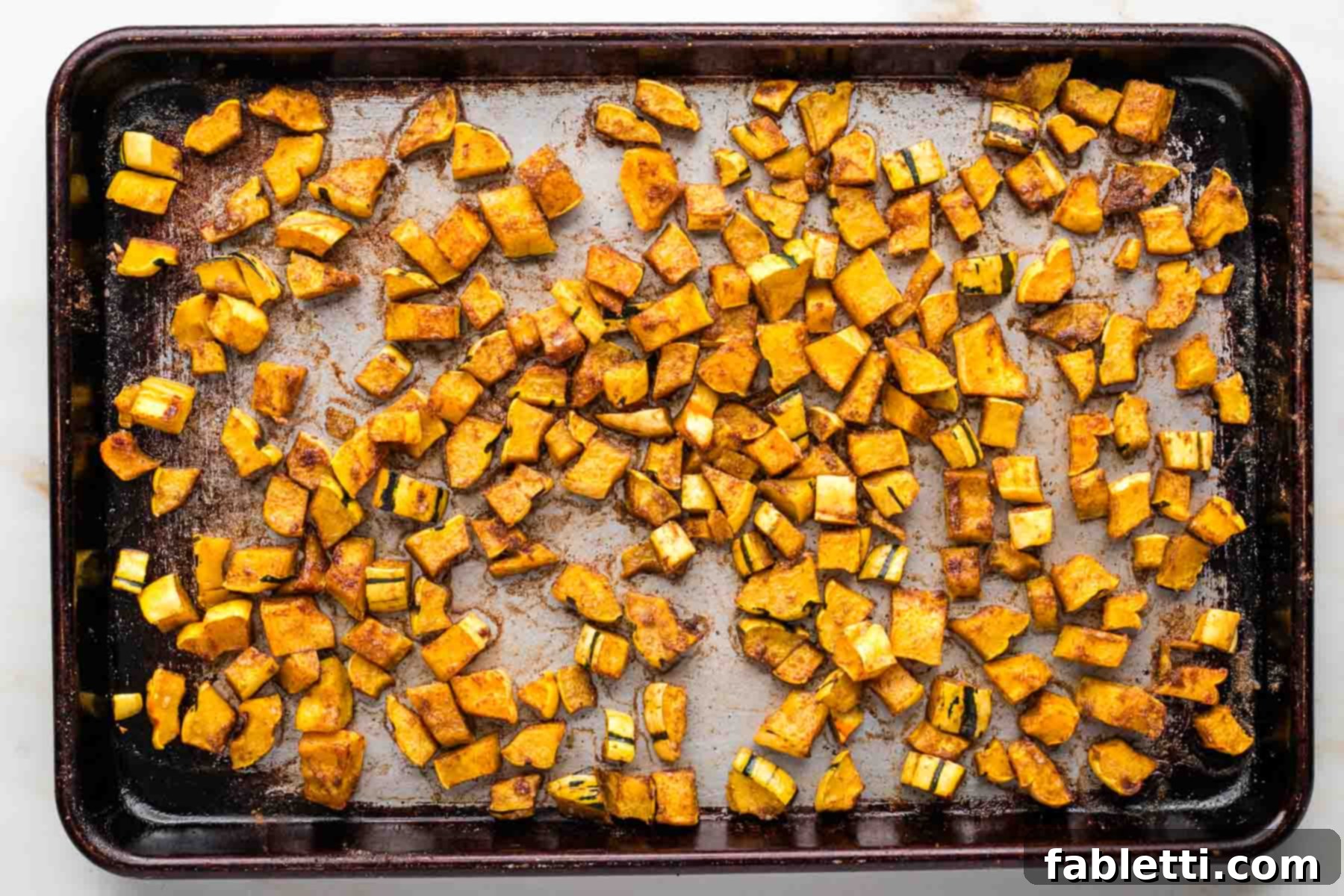
Place the baking tray into your preheated 400-degree Fahrenheit (200°C) oven and roast for approximately 15 minutes. For optimal texture and flavor, consider tossing the squash halfway through the cooking time to ensure all sides brown nicely. Keep an eye on the squash; it should be fork-tender and slightly caramelized at the edges. If you’ve cut your cubes slightly larger, they might require an additional 3 minutes, totaling up to 18 minutes, to reach that perfect softness. The result will be sweet, savory, and incredibly tender squash pieces ready to elevate your salad.
Crafting the Perfect Maple Vinaigrette
A homemade vinaigrette elevates any salad, and our Maple Vinaigrette is no exception. Its harmonious blend of sweet and tangy notes perfectly complements the rich flavors of roasted squash and pomegranate. This dressing is not only delicious but also incredibly simple to prepare, requiring minimal effort for maximum flavor impact.
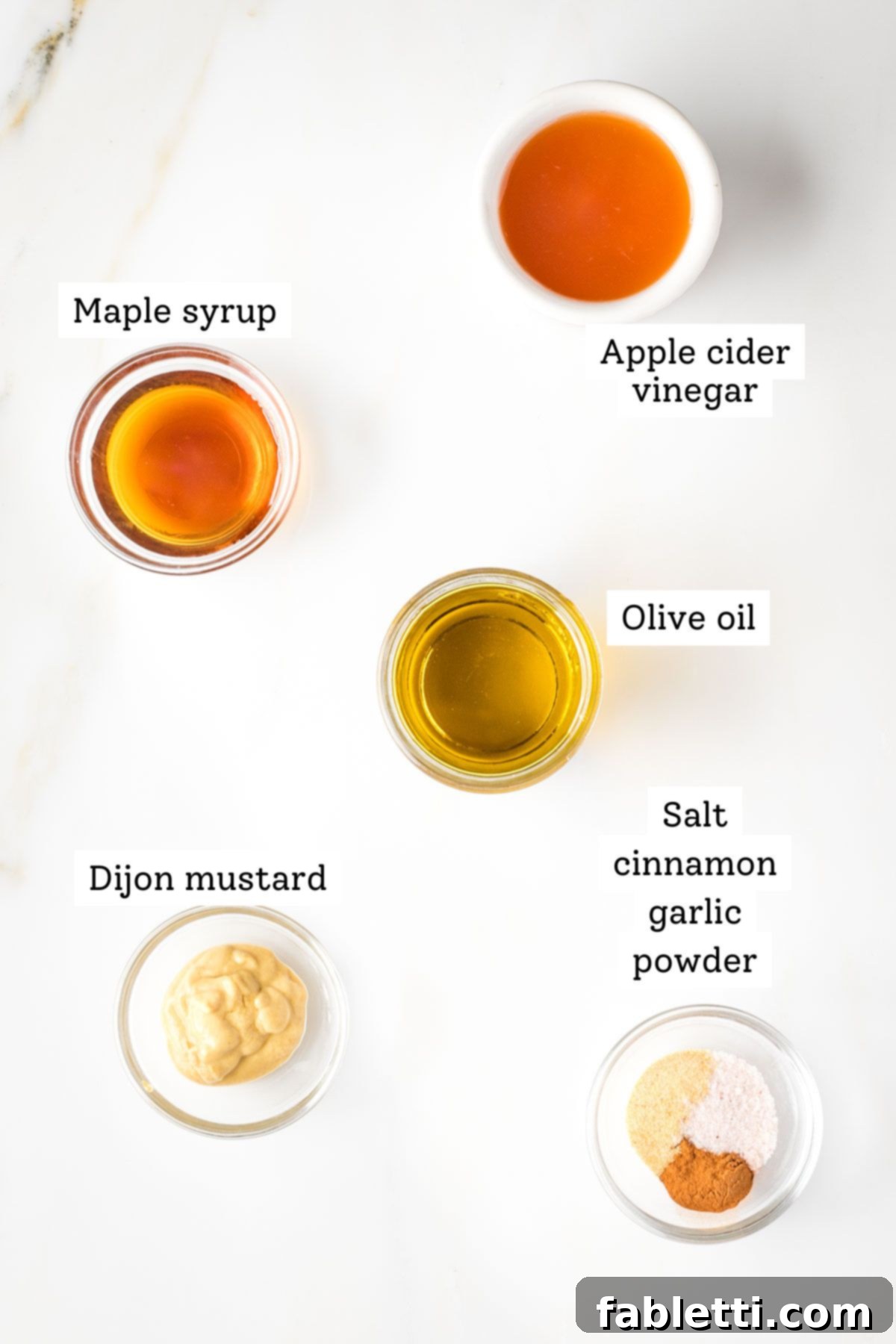
To begin crafting your Maple Vinaigrette, gather all your ingredients: pure maple syrup, apple cider vinegar, a good quality olive oil, Dijon mustard, a pinch of cinnamon, garlic powder, and a dash of sea salt. The quality of your olive oil and maple syrup can significantly impact the final taste, so choose wisely. Place all these measured ingredients into a small jar with a tight-fitting lid, a pitcher with a spout, or a mixing bowl. This straightforward approach minimizes cleanup and ensures all components are ready for blending.
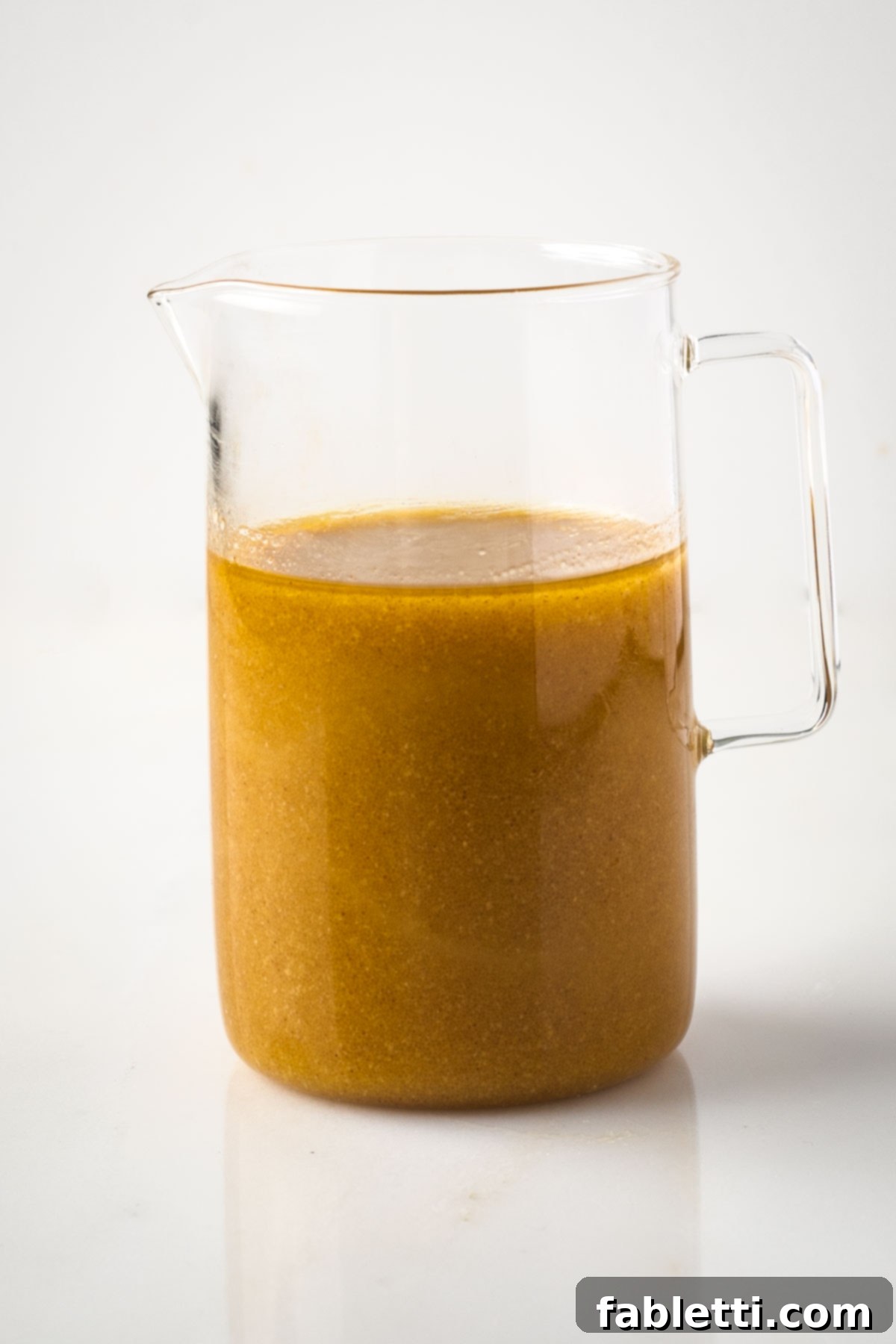
Now, it’s time to bring the dressing to life. If using a bowl, vigorously whisk the ingredients together until they are beautifully emulsified, meaning the oil and vinegar have blended into a creamy, uniform consistency. Ensure the spices are thoroughly incorporated throughout the mixture. If you’ve opted for a jar with a tight-fitting lid, simply secure the lid and shake vigorously for about 30-60 seconds until the dressing appears smooth and homogenous. This shaking method is particularly effective and fun! Taste and adjust seasonings if necessary, perhaps a little more salt or a touch more maple syrup to suit your preference. This versatile vinaigrette can also be stored in an airtight container in the refrigerator for up to two weeks, making it perfect for meal prepping.
Assembling Your Delectable Arugula Quinoa Salad
With your roasted squash golden and tender, your quinoa perfectly fluffy, and your maple vinaigrette ready to dazzle, it’s time to bring all the elements together to create this show-stopping salad. The assembly is simple, focusing on layering the ingredients to create a visually appealing and texturally rich dish.
Before you begin the final assembly, ensure all your components are prepped. Thinly slice the cabbage and shallot; precision in cutting ensures a delicate flavor and uniform texture in every bite. Cook the quinoa according to package directions – generally, this involves rinsing the quinoa thoroughly, combining it with double the amount of water (e.g., 1 cup quinoa to 2 cups water), bringing it to a boil, then reducing the heat to a simmer and cooking, covered, for about 15 minutes until all water is absorbed and the grains are fluffy. Let it sit for a few minutes off the heat, then fluff with a fork.
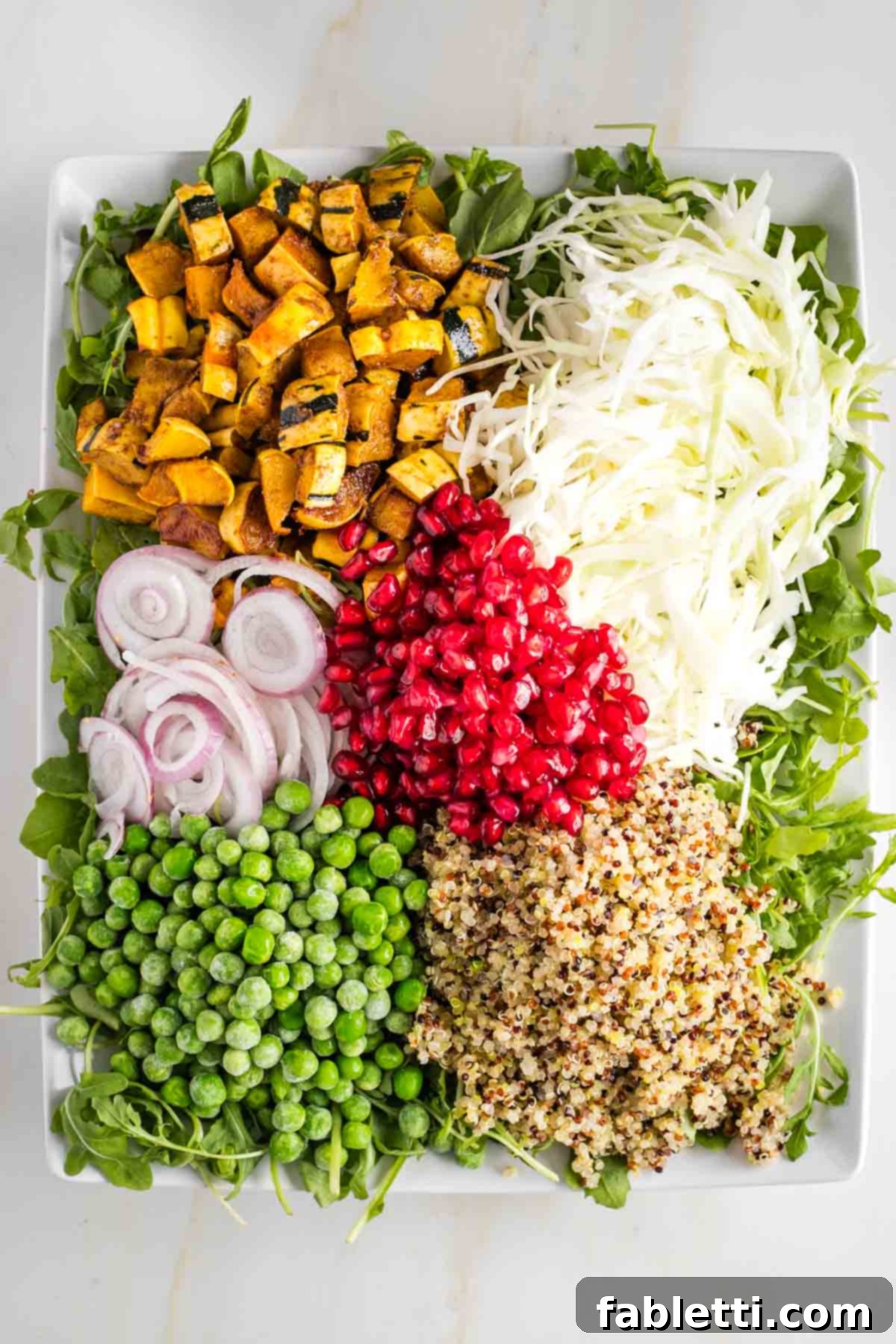
On a large serving platter or in a spacious bowl, create a vibrant bed of fresh arugula. The slightly peppery flavor of arugula forms an excellent foundation for the array of ingredients to follow. Next, artfully arrange the warm, spiced roasted squash cubes, the fluffy cooked quinoa, the crisp thinly sliced cabbage, and the delicate shallots on top of the greens. Sprinkle generously with the bright, jewel-like pomegranate seeds and the thawed frozen peas. The contrasting colors and textures create an inviting visual feast, promising a symphony of flavors.
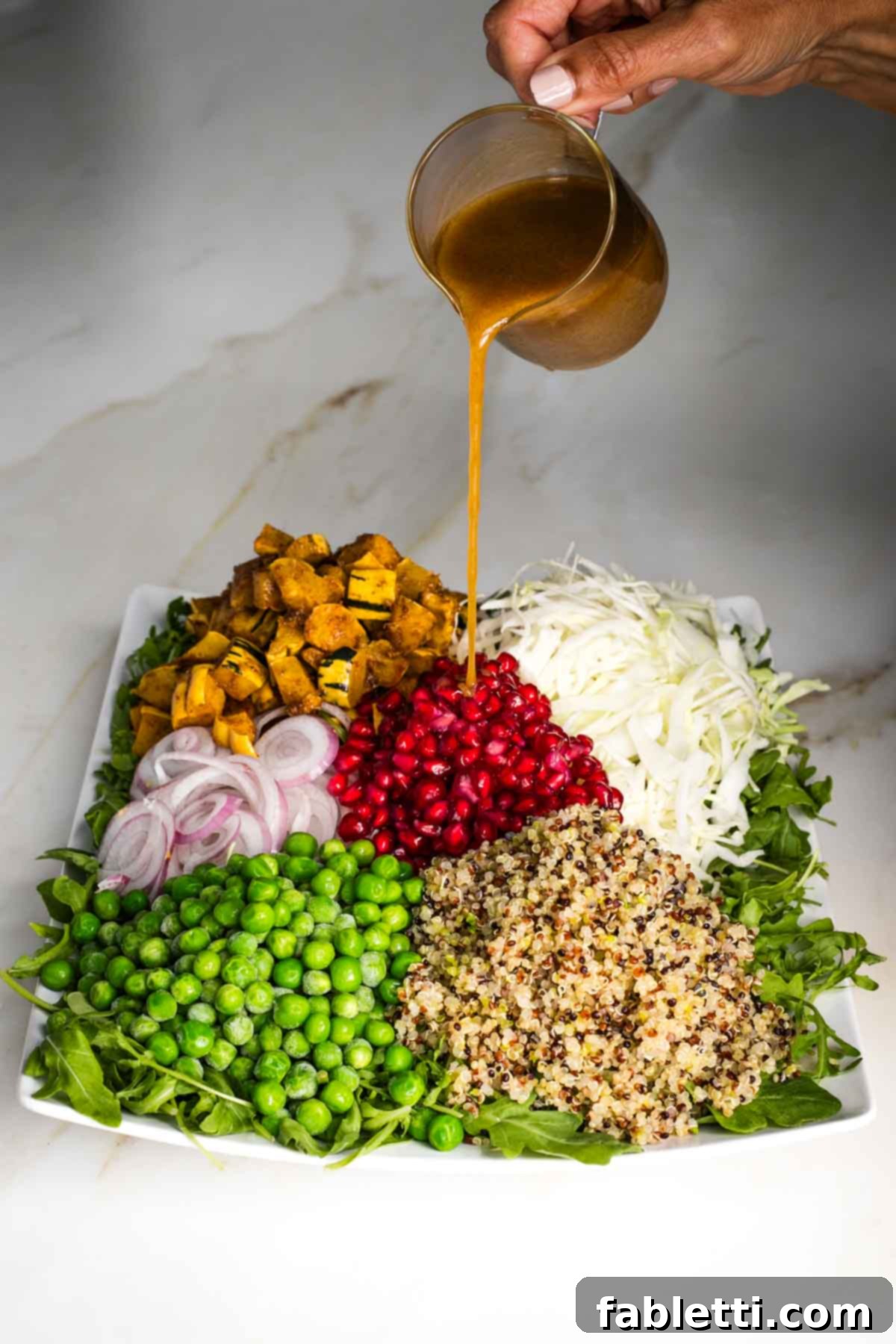
With all your beautiful components meticulously arranged, it’s time for the grand finale. Gently pour the homemade Maple Vinaigrette evenly over the entire composed salad. The dressing will weave its way through the layers, infusing every ingredient with its delightful sweet and tangy notes. Once dressed, use salad tongs to toss everything well, ensuring all the vegetables, quinoa, and squash are thoroughly coated and combined. This final toss distributes the flavors and textures, guaranteeing a perfect bite every time. Serve immediately and savor the incredible blend of autumnal flavors.
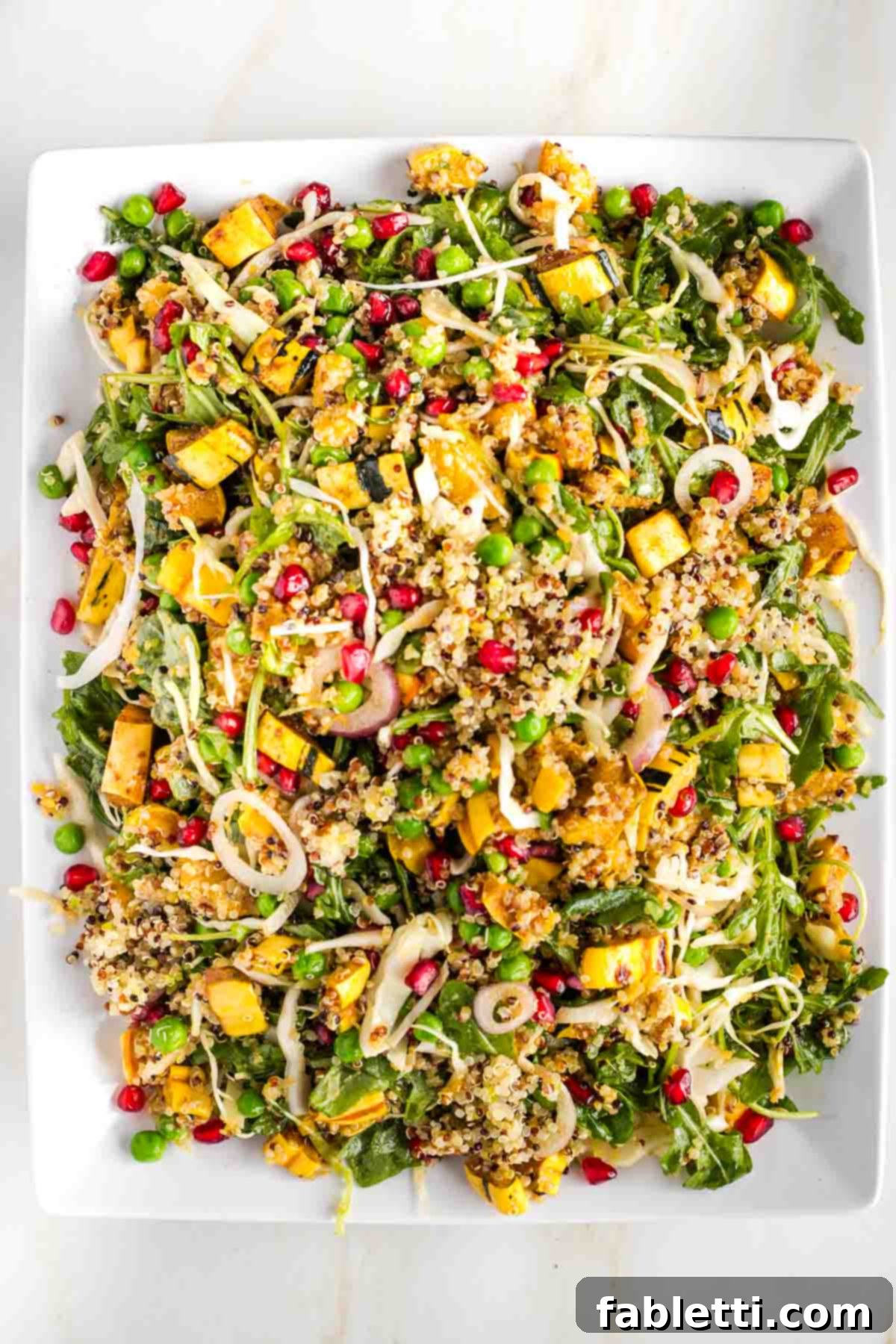
Expert Tips for an Even Better Salad Experience
Elevate your salad game with these insightful tips designed to streamline your preparation, enhance flavors, and make this dish a consistent winner in your kitchen. From smart shortcuts to delightful additions, these recommendations will help you personalize and perfect your Roasted Squash and Pomegranate Quinoa Salad.

- Time-Saving Pomegranate: Extracting arils from a whole pomegranate can be a bit messy and time-consuming. To save precious minutes and avoid the fuss, opt for pre-packaged pomegranate arils available in the produce section of most grocery stores. They offer the same vibrant color and juicy burst of flavor with none of the work.
- Embrace Flexibility with Veggies: Don’t feel constrained by exact amounts or specific vegetable types listed in the recipe. This salad is incredibly forgiving and adaptable. Feel free to use what you have on hand or what’s in season. For instance, swap green cabbage for red cabbage for a color pop, or use vibrant bell peppers instead of peas. Consider adding grated carrots or cucumber for extra freshness. The beauty of this recipe lies in its versatility, so get creative with your fridge’s bounty!
- Boost the Crunch Factor: For an added layer of texture and nutty flavor, sprinkle a handful of chopped walnuts, pecans, or pumpkin seeds (pepitas) over the finished salad. Toasting these nuts lightly beforehand can further intensify their flavor. This small addition provides a satisfying crunch that beautifully contrasts with the tender squash and soft quinoa.
- Grain Swaps: While quinoa is a fantastic choice for its nutritional benefits, any leftover cooked grains can be easily substituted. Cooked farro, couscous, brown rice, or even bulgur wheat would work wonderfully, each adding its unique texture and slightly different nutritional profile to the salad. This is a great way to utilize grains you already have prepared.
- A Spicy Kick: If you enjoy a bit of heat, consider adding a tiny pinch of cayenne pepper to your Maple Vinaigrette. This subtle addition will introduce a delightful warmth that balances the sweetness of the maple and adds an intriguing layer of complexity to the dressing, awakening the palate.
- Smart Meal Prep: To make assembling this salad almost instantaneous on a busy day, prepare the components in advance. Roast the squash and cook the quinoa up to three days ahead of time. Store them separately in airtight containers in the refrigerator. When you’re ready to eat, simply combine all the prepped ingredients, whisk the vinaigrette, and toss! This meal prep strategy allows you to enjoy a fresh, wholesome meal in just a couple of minutes.
Your feedback is invaluable and one of the best ways to support your favorite food bloggers. If you found joy in preparing this delightful recipe, please consider leaving a five-star rating below and sharing your thoughts in a comment. We also encourage you to share your beautiful culinary creations on Instagram by tagging @dkhealthcoach and using the hashtag #debraklein. We can’t wait to see your delicious results!
📖 Recipe: Roasted Squash and Pomegranate Quinoa Salad

Quinoa Arugula Salad with Pomegranate and Roasted Squash
Author: Debra Klein
This super fun and fabulously delicious quinoa and arugula salad is a true celebration of autumn flavors. With hearty roasted squash spiced to perfection, along with the sweet tang of pomegranate seeds and tender peas, this seasonal salad is satisfying enough to be a complete meal on its own or serve it as a vibrant and flavorful side dish.
No ratings yet
Rate this Recipe
Pin Recipe
Equipment
- Half Sheet Pan
- Grapefruit Spoons
Ingredients
- 1 cup dry quinoa (yields 3 cups cooked)
- 2 delicata squash
- 1 tablespoon olive oil
- 1 teaspoon cinnamon
- 1 teaspoon cumin
- 1 teaspoon coriander
- ½ teaspoon sea salt
- 5 oz arugula (about 4-5 cups)
- 3 cups shredded cabbage (about ½ head)
- 1 shallot (thinly sliced)
- 1 cup frozen peas
- 1 pomegranate (yields about 1 cup pomegranate arils)
Maple Vinaigrette:
- ¼ cup olive oil
- 2 tablespoon apple cider vinegar
- 2 teaspoon maple syrup
- 2 teaspoon Dijon mustard
- ¼ teaspoon salt
- ¼ teaspoon cinnamon
- ¼ teaspoon garlic powder
Instructions
Directions:
- Preheat oven to 400 degrees Fahrenheit (200°C).
- Cook quinoa: Rinse quinoa thoroughly in a fine-mesh sieve under cold running water. In a small saucepan, combine the rinsed quinoa with 2 cups of water. Bring the mixture to a boil, then reduce the heat to a simmer, cover, and cook for 15 minutes, or until all the water is absorbed and the quinoa is fluffy. Season with salt and pepper to taste, then fluff gently with a fork.
- Roast squash: Wash the outside of the delicata squash well and pat it completely dry. Trim off the stem ends, then carefully cut each squash in half lengthwise. Use a spoon (a grapefruit spoon works best) to scoop out the seeds and fibrous strands. Place each half skin-side down and cut into ¼-inch strips lengthwise, then cut across to create small ¼-inch cubes. Place the diced squash on a rimmed baking tray, drizzle with 1 tablespoon of olive oil, and sprinkle evenly with 1 teaspoon each of cinnamon, cumin, coriander, and ½ teaspoon of sea salt. Mix well to coat. Roast in the preheated oven for 15 minutes. If your cubes are slightly larger, they may need up to 18 minutes to become perfectly tender.
- Make maple vinaigrette: In a small jar with a tight-fitting lid, a pitcher, or a bowl, combine ¼ cup olive oil, 2 tablespoons apple cider vinegar, 2 teaspoons maple syrup, 2 teaspoons Dijon mustard, ¼ teaspoon salt, ¼ teaspoon cinnamon, and ¼ teaspoon garlic powder. If using a jar, shake vigorously until all ingredients are well blended and emulsified. If using a bowl, whisk thoroughly until smooth.
- Thinly slice the cabbage and shallot. If using a whole pomegranate, carefully remove the arils (seeds).
- Assemble the salad: On a large serving platter or in a spacious bowl, lay a generous bed of fresh arugula. Artfully arrange the warm roasted squash, fluffy cooked quinoa, vibrant pomegranate seeds, crisp shredded cabbage, sweet frozen peas, and thinly sliced shallot on top of the greens. Evenly pour the prepared maple vinaigrette over the composed salad. Using salad tongs, toss everything well to thoroughly combine all the ingredients and ensure every bite is bursting with flavor. Serve immediately.
Notes
Arugula Substitutions: While arugula adds a wonderful peppery note, feel free to use any hearty greens you prefer or have on hand. Excellent alternatives include kale, collard greens, or Swiss chard, which tend to hold up particularly well in salads, especially if you plan on having leftovers.
Vinaigrette Storage: Any leftover Maple Vinaigrette can be stored in an airtight container in the refrigerator for up to 2 weeks. Be sure to give it a good shake or whisk before each use, as the oil and vinegar may separate.
Salad Storage: This salad will keep well in the refrigerator for 4-5 days. Be aware that arugula may start to wilt slightly after 2 days. However, if you opt for heartier greens like kale, the salad will maintain its freshness and texture for the full 4-5 days, making it an excellent option for meal prepping throughout the week.
Nutrition
Calories: 347kcal
Carbohydrates: 50g
Protein: 9g
Fat: 14g
Saturated Fat: 2g
Polyunsaturated Fat: 2g
Monounsaturated Fat: 9g
Trans Fat: 0.01g
Sodium: 341mg
Potassium: 1042mg
Fiber: 9g
Sugar: 15g
Vitamin A: 2854IU
Vitamin C: 50mg
Calcium: 129mg
Iron: 4mg
Note on Nutrition
The nutrition calculations provided were estimated using online tools. To obtain the most accurate representation of the nutritional information for any given recipe, it is recommended that you calculate the nutritional information with the actual ingredients you used. You are ultimately responsible for ensuring that any nutritional information is accurate, complete, and useful for your dietary needs.
Did you make this recipe?
Please leave a review below, then snap a picture and tag me @dkhealthcoach or use hashtag #dkhealtcoach on Instagram so I can see it!!
